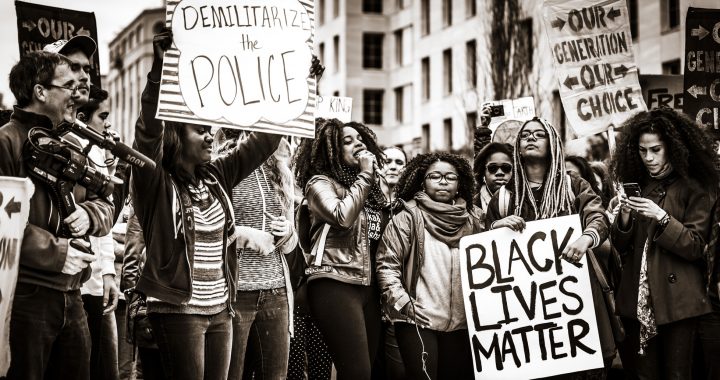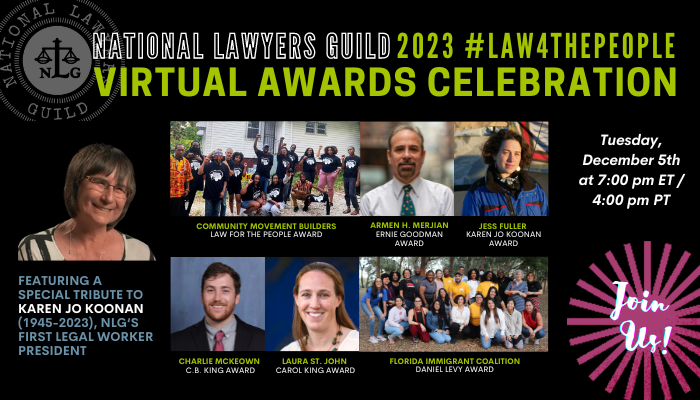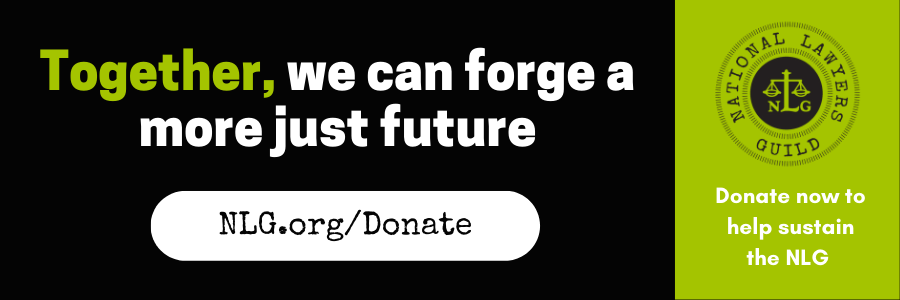By Tasha Moro, NLG Communications Director
Trials began last week in the historic prosecution of nearly 200 “J20” defendants indiscriminately arrested en masse during protests against Trump’s inauguration in Washington, DC, each facing more than 60 years in prison on rioting and property damage charges. In an affront to the First and Fourth Amendments, federal prosecutors seized more than 100 cell phones and obtained warrants for information of all visitors to the disruptj20.org website and those who “liked” their page on Facebook, among other personal social media data of organizers and participants.
In contrast, law enforcement’s laissez-faire attitude during August’s “Unite the Right” rally in Charlottesville, VA allowed white supremacists with guns, tiki torches, and Nazi flags to spew racial slurs and hate throughout the city for two entire days, culminating in the murder of anti-racist activist Heather Heyer on August 12. But unlike J20, there were no mass arrests in Charlottesville. No police deployment of concussion grenades, stingers, and pepper spray on people who were already detained. No holding people for hours without access to restrooms, food, and water. No subpoenas for organizers’ and participants’ personal data. After all, there were some “very fine people” among Unite the Right participants, according to the President.
In contrast to Charlottesville, nobody was murdered on J20. Yet to those in power, the massive display of resistance broadcast around the world that day embodied a far greater threat to the state than thousands of violent, hate-spewing white supremacists. Our sordid history shows that the law is not neutral. Evidenced by examples from the #BlackLivesMatter and #NoDAPL movements, COINTELPRO is alive and well—it just got a software update.
Rebooting COINTELPRO: The FBI Myth of the “Black Identity Extremist”
A few days before the “Unite the Right” rally, the FBI counterterrorism unit issued an internal “Intelligence Assessment” titled: Black Identity Extremists Likely Motivated to Target Law Enforcement Officers, revealed in an October exposé by Foreign Policy Magazine. Not long after being published, #COINTELPRO was trending on Twitter—a perfect manifestation of the once-covert FBI program’s new role and nefarious legacy into the 21st century.
You’ve probably never heard of “Black Identity Extremists” because they don’t exist. When Congresswoman Karen Bass questioned Attorney General Jeff Sessions about the FBI report last week, he wasn’t able to name a single “BIE” organization (nevertheless, Sessions admitted to not having read the report). The term was coined by the FBI in a thinly veiled attempt to legitimize the targeting of Black activists and the Black Lives Matter movement without appearing overtly racist. (Spoiler alert: they failed.)
The “Intelligence Assessment” reads: “The FBI assesses it is very likely Black Identity Extremist (BIE) perceptions of police brutality against African Americans spurred an increase in premeditated, retaliatory lethal violence against law enforcement and will very likely serve as justification for such violence (emphasis added).”
There are a number of reasons why this is an irresponsible and dangerous claim.
This myth of the “Black Identity Extremist” is a sensationalized, ambiguous label that is so vague it could be applied to anyone who is Black and involved in political organizing. Although never mentioned explicitly, the reference to the Black Lives Matter movement is obvious, as the report locates the contemporary resurgence of the “BIE movement” in Ferguson, MO following Michael Brown’s murder. It mentions that “BIE violence peaked in the 1960s and 1970s,” naming the Black Liberation Army as one example of a “BIE” organization. The BIE category is so broad, that two completely different entities with distinctly different ideologies are lumped into the same category primarily due to the fact they are both Black-led.
The report’s basis for claiming that violence against law enforcement is the result of “BIE”-coordinated political organizing is patently false. The few examples cited are merely ones in which suspects are Black individuals. According to the FBI’s analysis, this is enough to attribute such acts to Black-led movements against racist policing at large.
Perhaps equally disturbing is the FBI’s claim that “perceptions of police brutality against African Americans” are to blame, rather than acknowledging actual reality. Literally adding insult to injury, the report is chock-full of mentions of a “perceived” injustice toward Black Americans. For instance, the phrases “perceptions of unjust treatment,” “perceived unchallenged illegitimate actions of law enforcement” and “perceived oppressive law enforcement system,” appear within a single paragraph.
Such deliberate mischaracterizations ultimately pathologize Black people for naming their own oppression, insisting that movements like Black Lives Matter are driven by arbitrary ideology and imagined grievances. (In other words, gaslighting.) But we’ve seen this type of manipulation before.
Conflating activism with terrorism in order to undermine resistance movements is a tried and true tactic of the state. From the 1950s to the 1970s, then-FBI director and McCarthyism architect J. Edgar Hoover headed the Counterintelligence Program (COINTELPRO) which aimed to “expose, disrupt, misdirect, discredit, or otherwise neutralize” activists and civil rights groups critical of US government. Examples of these were anti-war groups, the American Indian Movement, Black Panther Party, NAACP, Southern Christian Leadership Conference, the Puerto Rican Independence Movement, Students for a Democratic Society, and yes, the National Lawyers Guild.
Methods were brutal and often illegal, including infiltration, wiretapping, spying, issuing false media reports, harassment, and even murder. One particularly sinister tactic was manufacturing conflict within organizations or against individuals by sending them anonymous letters—perhaps the most notorious example being the FBI’s “suicide letter” (along with a tape that held secret recordings of him and his affairs) sent to Martin Luther King, Jr. Sent just two days after King was awarded the Nobel Peace Prize, it is evident that the focus of the FBI’s program was not protecting national domestic security, but quashing successful political organizing—especially that which threatens the perpetuation of white supremacy.
The establishment viewed the success of the country as inextricably linked to its perpetuation of racial oppression. As one FBI official wrote after King delivered the “I Have a Dream” speech, “We must mark [King] now… as the most dangerous Negro in the future of this Nation.” Another 1968 FBI memo warned of a vaguely defined “effective coalition of black nationalist groups,” echoing the Bureau’s “BIE” rhetoric today.
* * *
#BlackLivesMatter
While COINTELPRO was officially disbanded in 1971, state surveillance and disruption of social movements live on, with deepened collusion between private and public entities. The post-9/11 political landscape has been fertile ground for Islamophobia and other iterations of religious and ethnic profiling. With relaxed privacy protections following the passage of the Patriot Act, federal and local law enforcement have heavily profiled, surveilled, harassed, and entrapped Muslim Americans on the basis of little else than their religious and ethnic background—skirting constitutional protections in the name of “counterterrorism.” Since the election of Donald Trump, Black and Brown immigrants have experienced increased levels of harassment and abuse from Washington, including plans for the Department of Homeland Security’s (DHS) automated “Extreme Vetting Initiative,” condemned by 100+ civil groups as a “digital Muslim ban.”
The FBI, DHS, and even some local police departments have massive resources at their disposal to pour into the latest surveillance technology and online data mining systems. Today, the 77 multi-million dollar fusion centers that operate in cities nationwide—the majority of them established under DHS at the height of the “war on terror” between 2003 and 2007—are among the first users of these new technologies. These “information-sharing” hubs include local, state, and federal law enforcement and intelligence agencies often along with private sector intelligence corporations and/or military personnel.
While their stated purpose is to “enhance the national threat picture” in order to “prevent acts of terrorism on American soil,” mission creep has resulted in fusion centers dedicating much of their efforts to surveilling communities and COINTELPRO-like disruption of anti-war groups (see Panagacos v. Towery), Occupy Wall Street, animal rights, and environmental justice activists in the name of “counterterrorism.” Despite a two-year investigation documented in a 2012 Senate report finding them to be costly and ineffective by producing inaccurate results infringing on civil liberties, fusion centers continue to conduct business as usual.
What would become a global movement, the #BlackLivesMatter hashtag was born out of a single social media post by Alicia Garza in response to the acquittal of George Zimmerman in the murder of Trayvon Martin in 2013. She, along with two other queer Black women organizers, Patrisse Cullors and Opal Tometi, decided to amplify what they deemed a “call to action” against systemic racism by leveraging the power of social media. As people took to the streets in Ferguson, MO following the police murder of Michael Brown in August 2014, #BlackLivesMatter quickly became a household phrase.
#BlackLivesMatter has had a singular role in movement building and influencing public opinion unlike any hashtag campaign before. It was used to organize protests and direct actions, tag news on police brutality and racism, and offer solidarity across borders. Organizers also used Facebook event pages and opt-in text alert services and quickly spread the word about protests and update location info in real time. The downside, of course, is that law enforcement has access to this information, too and fusion centers regularly surveilled BLM activists and related activity.
In NYC, for example, it’s not uncommon to see NYPD at a protest site before organizers even arrive—signaling the department’s tracking of online organizing. In fact, responding to the nearly daily protests that took place throughout the city at the height of the Black Lives Matter movement, the NYPD created its own unit to deal with protests almost exclusively—although ostensibly, it’s also supposed to be an anti-terror squad.
In January 2015, NYPD Police Commissioner Bill Bratton unveiled plans for the high-tech “Strategic Response Group” which would become active in May of that year. Originally planned to have 350 officers, the SRG has swelled to 800, outfitted with state-of-the-art surveillance technology, riot gear, assault rifles, and military grade LRAD sound cannons. Donning helmets and bulletproof vests emblazoned with “NYPD STRATEGIC RESPONSE GROUP” or “NYPD COUNTERTERRORISM,” the squad’s mere presence at demonstrations perpetuates the dangerous conflation of terrorism and dissent, providing tourists and passersby a visual that can make the most mundane gatherings appear threatening or dangerous.
While these optics are a rather blatant display of law enforcement policing dissent, the NYPD has a long history of covert surveillance operations that employed tactics straight out of the COINTELPRO playbook. In July 2015, an article by The Intercept detailed how the DHS surveilled Black Lives Matter organizing since protests began in Ferguson. By then, protests had also broken out in Baltimore, MD in response to the police killing of Freddie Gray in April 2015, and another wave of demonstrations emerged nationwide. In both cities, the FBI covertly deployed airplanes with infrared cameras to monitor the protests, raising serious privacy and racial profiling concerns when considering the increased use of facial recognition by law enforcement. In Baltimore, for example, police used the technology to identify protesters with individuals who had outstanding warrants. DHS regularly tracked location data through social media surveillance and for purposes of “situational awareness” tracking #BlackLivesMatter and other related hashtags.
“StingRays,” or cell-site simulators, imitate cell towers to access social media, text, voice, and other communications data, allowing law enforcement to police demonstrations and track organizers’ next moves. Activists have also experienced other forms of smartphone sabotage, including having phones mysteriously power off for the entire duration of a protest, conveniently undermining crucial logistical communications between organizers. Lawsuits in New York and Chicago have challenged their covert use by law enforcement during Black Lives Matter protests.
These efforts seem to lie far beyond the powers of a national security agency created in response to the 9/11 attacks, and instead has become a method to intimidate activists and chill the right to dissent. As the publication notes, it wasn’t just protests that DHS monitored, but also community events in historically Black neighborhoods, like the Funk Parade and Avon 39-Walk to End Breast Cancer in DC. This intimidation, profiling, and criminalization of communities of color in the name of “security” is a pillar of systemic racism that the mainstream media often supports, while the threat of white supremacy is often downplayed and white terrorists afforded the benefit of the doubt.
* * *
#NoDAPL
In a remote area with limited internet access and media presence, the #NoDAPL movement at Standing Rock against construction of the Dakota Access Pipeline (DAPL) also gained visibility and support online. In this instance, a private security firm hired by multibillion-dollar oil and gas corporation Energy Transfer Partners (ETP) named TigerSwan, led efforts to undermine the Indigenous-led movement. Following a leak of 100+ internal documents, The Intercept published a damning investigative series on TigerSwan’s COINTELPRO-esque tactics at Standing Rock carried out in collaboration with local state and federal law enforcement agencies including the FBI, DHS and Bureau of Indian Affairs—in essence, an unofficial fusion center. As a private company, TigerSwan could operate in the shadows with little to no oversight, and in contrast to government agencies, they were not required to uphold the rights of citizens. However, “The line between private security and law enforcement at DAPL has been nonexistent,” as NLG member and Water Protector Legal Collective board member Bruce Ellison told the Intercept. ETP hired TigerSwan to protect its interests and ensure that construction of the pipeline and its profits could continue as planned—no matter the human cost.
TigerSwan’s “surveillance dragnet” spanned at least five states, infiltrated activist circles with informants, used aerial surveillance to record water protectors and the camp, heavily surveilled #NoDAPL activists and their social media, tracked protests, and deployed an online PR campaign to discredit the movement and misinform the public. In fact, seven TigerSwan employees who comprised their so-called “social media cell” were tasked exclusively with monitoring and uncovering private content on Facebook, Twitter, and the like. The company even developed “person of interest” files with law enforcement that delved deep into the personal lives of activists at the camp.
As a former private contractor for the US military and State Department in the “war on terror,” TigerSwan treated the resistance at Standing Rock as a military operation in counterterrorism. In internal reports to ETP, TigerSwan referred to the encampment as a “battlefield,” protesters as “terrorists” and called for “aggressive intelligence preparation” to defeat “pipeline insurgencies.” TigerSwan profiled water protectors, warning ETP of “Palestinians in the camps and the movement’s involvement with Islamic individuals” and described one woman as “strong Shia Islamic” who had “made several trips overseas.”
Like the FBI’s classification of “Black Identity Extremists” as nonsensical fanatics motivated by nothing more than a shared race or culture, TigerSwan described the Standing Rock movement as “an ideologically driven insurgency with a strong religious component” that “followed the jihadist insurgency model.” Never mind the desecration of sacred sites, the threatened water supply of millions, and the immediate harm DAPL poses to the environment, TigerSwan promoted the notion that water protectors are driven by arbitrary ideology, rather than common sense.
For the first several months, media presence at Standing Rock was scarce. Most of the coverage was provided by indigenous and other independent media groups—sometimes individual water protectors—via cellphone to social media platforms. This was already a task in itself, as reliable cell phone reception was rare at the camp. In fact, it is believed that TigerSwan and/or law enforcement deliberately engaged in cell phone interference. Likely caused by Stingray devices as in the case of Black Lives Matter protests, water protectors found that cell signals inexplicably dropped and phones randomly powered off.
To the satisfaction of TigerSwan and ETP, none of the major US outlets had set foot in the camp, and mainstream news reporters largely steered clear of the story. But on September 3, the threat of independent media was made clear to DAPL when journalist Amy Goodman and the crew from Democracy Now! captured disturbing footage of injuries following an attack on water protectors by TigerSwan security who pepper sprayed and sicced dogs on them. To ETP and TigerSwan’s horror, the video went viral— garnering 14 million views on Facebook and finally provoking coverage by mainstream US news. On September 8, the Morton County Sheriff’s Department issued a warrant for Goodman’s arrest, who was charged with criminal trespassing. But after continued coverage by Democracy Now!, DA Ladd Erickson leveled more serious “riot” charges against Goodman, which were consequently rejected by a North Dakota judge.
Echoing Trump and the Right’s ”paid protesters” myth (and ETP/TigerSwan’s PR narrative) Erickson stated, “Some DAPL protester videos are designed for fundraising, to get actors weeping into cameras. Pretend journalists like Amy Goodman of Democracy Now or The Young Turks have published manipulated DAPL social media videos with faux narratives in an attempt to be recognized as a news source by those who are duped by fake news,” Erickson said. (Currently, ETP is suing NGOs Greenpeace, Earth First, and BankTrack for $300 million in damages under the RICO Act in a claim that the efforts against DAPL by this ”network of putative not-for profit and rogue eco-terrorist groups” deployed a “fabricated environmental claims” in order target “legitimate industries” and increase donations.)
Independent media collective Unicorn Riot had been providing on-the-ground coverage since the Sacred Stone Camp was established April 1, 2016. In addition to written reporting, much of their coverage was livestreaming—a medium often targeted by law enforcement in protest contexts. This raw, uncensored footage of the struggle broadcast in real time threatened to undermine the DAPL PR campaign as journalists exposed what others dared not cover. Unicorn Riot was livestreaming a direct action to Facebook on September 13, when two of their journalists were arrested—but Facebook blocked the stream right before it aired capturing critical footage of the actual arrests. Facebook security alerts appeared, deeming that their “security systems detected [the link] to be unsafe.”
But much of the grassroots reporting that came out of Standing Rock was from water protectors themselves, including No Spiritual Surrender, Indigenous Environmental Network and Digital Smoke Signals. Taking to Facebook and Twitter, camp members regularly livestreamed construction activity as well as arrests, surveillance, and brutality by law enforcement against camp members, accounting for much of the footage that put #NoDAPL on the digital map.
On October 25, in response to water protectors using drones to report news coming out of the camp (for which some were arrested) the Federal Aviation Administration (FAA) issued a rare “no fly zone” order in effect until November 4, 2016, reminiscent of the one issued during the 2014 Black Lives Matter protests in Ferguson, MO, which St. Louis police had admitted were to facilitate a media blackout. Meanwhile, TigerSwan continued aerial surveillance with low-flying helicopters patrolling the camp day and night.
As the total 700 arrests of water protectors at Standing Rock would illustrate, criminal prosecution was an explicit goal of TigerSwan, who were tasked with collecting “information of an evidentiary level” to “aid in prosecution” of protesters. A tactic straight out of COINTELPRO, they leveled the legal system against water protectors in an effort to chill dissent, discredit the #NoDAPL movement, and ensure construction would move forward. The repression continues to this day, as 400 of the Standing Rock arrestees still await trial. And Sophia Wilansky—who lost use of her left hand after nearly having her arm torn off during the violent police attack that injured 300 water protectors at Backwater Bridge one year ago today—continues to be investigated by the FBI due to the claim (promoted by TigerSwan) that she was somehow involved in constructing explosives devices. Last spring, they obtained a warrant for her Facebook account.
* * *
Looking Ahead
Retaliation and intimidation through criminal prosecution should never come as a surprise in the context of state attempts to quash dissent. Dozens of aging political prisoners incarcerated because of COINTELPRO remain in prison to this day, and new political prisoners are created every time people are incarcerated as a result of constitutionally protected activism.
The press has always played a crucial role in political movements, and media outlets can either act responsibly by reporting the truth on resistance movements, or be complicit in undermining democracy by spreading misinformation or ignoring them completely. Under COINTELPRO, the FBI relied on actual “fake news”—publishing false news stories in mainstream newspapers, or even creating fake grassroots publications—to publicly smear movements or sow discord within organizations. Given the fact that just six corporations own 90% of all US media, independent journalism has never played a more crucial role in our social movements.
The right to protest and a free press are critical for democracy to work, and we are seeing both of these are threatened by the very powers that are supposed to protect them. We must remain vigilant as elected officials move to threaten the most basic tenets of an open and free society with anti-protest legislation. We must support J20 defendants and other social justice activists targeted by the state. We must defend net neutrality and independent journalism engaged in truth-telling eschewed by corporate news machines. And we must uplift the movements powered by people who refuse to back down—and understand that we can be those people, too.
#
Photo: “Demilitarize the Police, Black Lives Matter” by Johnny Silvercloud, used under CC BY-SA 2.0




